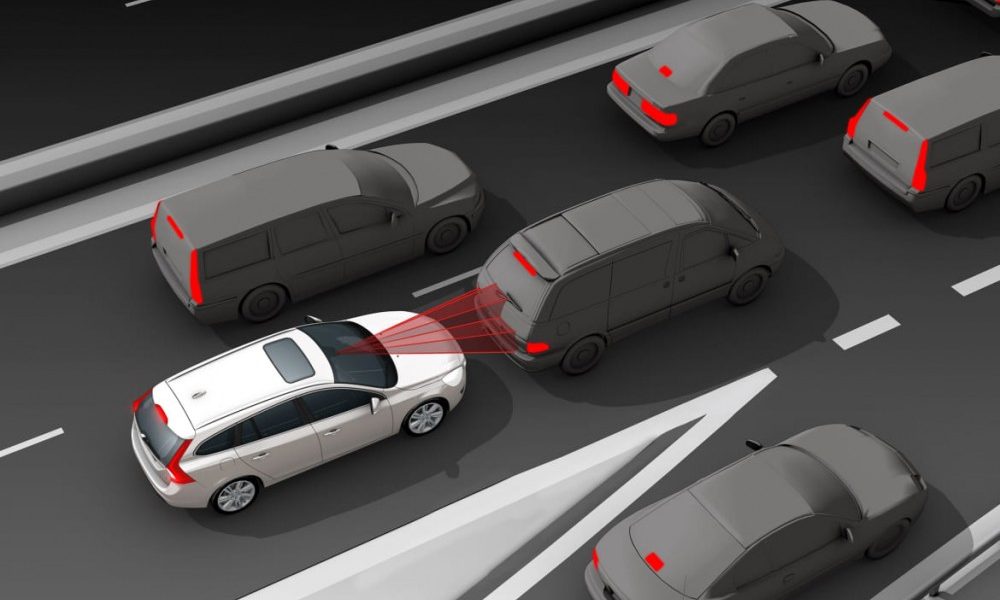AutoAfterWorld.COM — It may still be a while before you can buy a car that drives itself, but a deal announced today by automakers, safety regulators and safety advocates will speed up the availability of cars that stop themselves.
A coalition of 20 automakers have agreed with the National Highway Traffic Safety Administration and the Insurance Institute for Highway Safety to make collision avoidance systems with automatic emergency braking standard on almost all new cars by September 2022; heavy-duty trucks have until September 2025.
Related: Several Automakers Commit to Standard Auto-Braking
The industry coalition "accounts for 99.6 percent of all new vehicles sold in the U.S.," said NHTSA head Mark Rosekind at a press conference and demonstration of the technology in several cars at the Federal Highway Administration research center here in McLean, Va. "The commitment [to make it standard] ensures that all Americans will benefit from this technology," said David Zuby, chief research officer for IIHS.
Collision avoidance systems with automatic emergency braking use cameras, radar or other technology to sense an impending collision, prepare the car's safety systems — and hit the brakes if the driver does not react quickly enough, avoiding the crash or lessening the impact. NHTSA ramped up efforts last year to promote the systems, with strong backing from IIHS, which reserves its top crash-test rating, Top Safety Pick Plus, for cars that offer the system.
IIHS estimates that the technology could cut rear-end crashes by 40 percent. According to a report in June from the National Transportation Safety Board, more than 80 percent of the 1,700 deaths and half-million injuries a year in rear-end crashes could be avoided or mitigated if all vehicles had automatic emergency braking systems.
The voluntary agreement will substantially accelerate the availability of the technology, according to NHTSA, which said it "realistically" would take until 2025 to put in place a mandate. NHTSA and IIHS, along with Consumer Reports, which also tests such systems and has promoted their adoption, will monitor automakers' progress.
Each automaker will create its own schedule to meet the goal, Rosekind said. He predicted that since technology has become a major point of competition in new cars, automakers may beat the timetable. The cost per car could vary with the vehicles and type of system — an average additional cost per car was not provided.
Auto companies signing on (including their various brands) are GM, Ford, Fiat Chrysler Automobiles, Tesla, Toyota, BMW, Daimler, Mazda, Subaru, Maserati, Porsche, Volvo, Volkswagen Group, Hyundai-Kia, Mitsubishi and Jaguar Land Rover.
Limited not so long ago to a few luxury cars, the systems already have been spreading to mainstream and smaller vehicles, at least as options.
"We've said it before, but it bears repeating — we are committed to the democratization of advanced safety technologies," said Mike Dahl, head of vehicle safety and regulatory compliance for Fiat Chrysler Automobiles, in a statement.
Current systems vary widely in capability and cost. The simplest and cheapest are camera-based and generally can fully stop the vehicle before impact at low speeds. More sophisticated systems can avoid or mitigate collisions at higher speeds. Generally adding multiple sensors, including radar, some can "see" not just the vehicle directly ahead, but also two or three vehicles beyond. Some also can spot pedestrians, bicyclists or animals in your path and brake for them if you don't.
Today's deal adds a six-year countdown — and virtually the rest of the auto industry – to a commitment announced in September 2015 by nine automakers to make forward collision warning systems with automatic emergency braking standard.
The industry has a long way to go. A Cars.com analysis of automaker and IIHS data for the top 30 best-selling models in the U.S. — which account for about half of all new-car sales so far this year, according to Automotive News — found that 14 have only forward collision warning without automatic braking or no forward collision warning at all. The group includes some of the most best-selling models in the country, such the Ford F-Series, Chevrolet Silverado and Ram pickups.
Even among the remaining 16 cars that do offer such systems, none offer the systems as standard equipment for the 2016 model year, Cars.com found. In many cases you can only get them with higher trim levels or in costly packages. Take the 2016 Toyota Highlander SUV: Its forward collision warning with automatic emergency braking comes only on the Limited Platinum trim level, the priciest of its five trims; it accounts for just 10.7 percent of the Highlander's national new-car inventory on Cars.com. For 2017 Highlander models, however, Toyota recently announced the system will be standard. Popular models such as the Hyundai Sonata, Nissan Rogue and Toyota Sienna offer the system only as an option atop their highest trim levels. In effect, you have to buy a fully loaded car to get it.
Some automakers — Subaru and Honda, for example — buck the trend with wider availability across mainstream trim levels. But for now, that's more the exception than the rule.
The good news? The industry can ramp up quickly. Take another important safety technology, electronic stability systems, which have been required since the 2012 model year. Six years before that — a similar lead time to today's 2022 announcement — stability systems were standard in just 41 percent of new cars, according to IIHS. In 2007, NHTSA announced plans to require the systems by the 2012 model year, and by 2009, 74 percent of all new cars already had them standard.
Right now, less than 41 percent of new cars have standard forward collision warning with automatic braking — but about half of all models at least offered it in some way in 2015, according to Zuby, and automakers have shown they can change things fast. They'll have to if they are to meet this target.



Leave a Reply